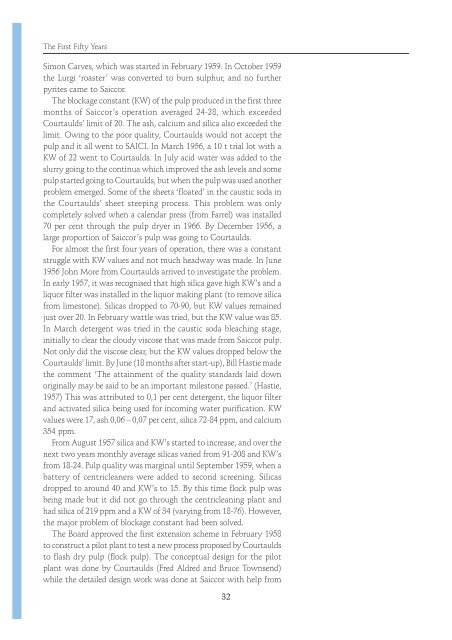You also want an ePaper? Increase the reach of your titles
YUMPU automatically turns print PDFs into web optimized ePapers that Google loves.
<strong>The</strong> <strong>First</strong> Fifty <strong>Years</strong><br />
Simon Carves, which was started in February 1959� In October 1959<br />
the Lurgi ‘roaster’ was converted to burn sulphur, and no further<br />
pyrites came to <strong>Saiccor</strong>�<br />
<strong>The</strong> blockage constant (KW) of the pulp produced in the first three<br />
months of <strong>Saiccor</strong>’s operation averaged 24-28, which exceeded<br />
Courtaulds’ limit of 20� <strong>The</strong> ash, calcium and silica also exceeded the<br />
limit� Owing to the poor quality, Courtaulds would not accept the<br />
pulp and it all went to SAICI� In March 1956, a 10 t trial lot with a<br />
KW of 22 went to Courtaulds� In July acid water was added to the<br />
slurry going to the continua which improved the ash levels and some<br />
pulp started going to Courtaulds, but when the pulp was used another<br />
problem emerged� Some of the sheets ‘floated’ in the caustic soda in<br />
the Courtaulds’ sheet steeping process� This problem was only<br />
completely solved when a calendar press (from Farrel) was installed<br />
70 per cent through the pulp dryer in 1966� By December 1956, a<br />
large proportion of <strong>Saiccor</strong>’s pulp was going to Courtaulds�<br />
For almost the first four years of operation, there was a constant<br />
struggle with KW values and not much headway was made� In June<br />
1956 John More from Courtaulds arrived to investigate the problem�<br />
In early 1957, it was recognised that high silica gave high KW’s and a<br />
liquor filter was installed in the liquor making plant (to remove silica<br />
from limestone)� Silicas dropped to 70-90, but KW values remained<br />
just over 20� In February wattle was tried, but the KW value was 85�<br />
In March detergent was tried in the caustic soda bleaching stage,<br />
initially to clear the cloudy viscose that was made from <strong>Saiccor</strong> pulp�<br />
Not only did the viscose clear, but the KW values dropped below the<br />
Courtaulds’ limit� By June (18 months after start-up), Bill Hastie made<br />
the comment ‘<strong>The</strong> attainment of the quality standards laid down<br />
originally may be said to be an important milestone passed�’ (Hastie,<br />
1957) This was attributed to 0,1 per cent detergent, the liquor filter<br />
and activated silica being used for incoming water purification� KW<br />
values were 17, ash 0,06 – 0,07 per cent, silica 72-84 ppm, and calcium<br />
354 ppm�<br />
From August 1957 silica and KW’s started to increase, and over the<br />
next two years monthly average silicas varied from 91-208 and KW’s<br />
from 18-24� Pulp quality was marginal until September 1959, when a<br />
battery of centricleaners were added to second screening� Silicas<br />
dropped to around 40 and KW’s to 15� By this time flock pulp was<br />
being made but it did not go through the centricleaning plant and<br />
had silica of 219 ppm and a KW of 34 (varying from 18-76)� However,<br />
the major problem of blockage constant had been solved�<br />
<strong>The</strong> Board approved the first extension scheme in February 1958<br />
to construct a pilot plant to test a new process proposed by Courtaulds<br />
to flash dry pulp (flock pulp)� <strong>The</strong> conceptual design for the pilot<br />
plant was done by Courtaulds (Fred Aldred and Bruce Townsend)<br />
while the detailed design work was done at <strong>Saiccor</strong> with help from<br />
32

















